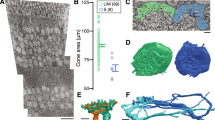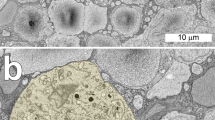Abstract
We examined the functional microcircuitry of cone inputs to blue-ON/yellow-OFF (BY) ganglion cells in the macaque retina using multielectrode recording. BY cells were identified by their ON responses to blue light and OFF responses to red or green light. Cone-isolating stimulation indicated that ON responses originated in short (S) wavelength-sensitive cones, whereas OFF responses originated in both long (L) and middle (M) wavelength-sensitive cones. Stimulation with fine spatial patterns revealed locations of individual S cones in BY cell receptive fields. Neighboring BY cells received common but unequal inputs from one or more S cones. Inputs from individual S cones differed in strength, indicating different synaptic weights, and summed approximately linearly to control BY cell firing.
This is a preview of subscription content, access via your institution
Access options
Subscribe to this journal
Receive 12 print issues and online access
$209.00 per year
only $17.42 per issue
Buy this article
- Purchase on Springer Link
- Instant access to full article PDF
Prices may be subject to local taxes which are calculated during checkout






Similar content being viewed by others
References
Wiesel, T. & Hubel, D. H. Spatial and chromatic interactions in the lateral geniculate body of the rhesus monkey. J. Neurophysiol. 29, 1115–1156 ( 1966).
Dacey, D. M. & Lee, B. B. The 'blue–on' opponent pathway in primate retina originates from a distinct bistratified ganglion cell type. Nature 367, 731–735 (1994).
Mariani, A. P. Bipolar cells in monkey retina selective for the cones likely to be blue-sensitive. Nature 308, 184–186 (1984).
Kouyama, N. & Marshak, D. W. Bipolar cells specific for blue cones in the macaque retina. J. Neurosci. 12, 1233–1252 (1992).
Wässle, H., Grunert, U., Martin, P. R. & Boycott, B. B. Immunocytochemical characterization and spatial distribution of midget bipolar cells in the macaque monkey retina. Vision Res. 34, 561–579 (1994).
Calkins, D. J., Tsukamoto, Y. & Sterling, P. Microcircuitry and mosaic of a blue-yellow ganglion cell in the primate retina. J. Neurosci. 18, 3373–3385 (1998).
Meister, M., Pine, J. & Baylor, D. A. Multi-neuronal signals from the retina: acquisition and analysis. J. Neurosci. Methods 51, 95–106 (1994).
De Valois, R. L. Analysis and coding of color vision in the primate visual system. Cold Spring Harb. Symp. Quant. Biol. 30, 567– 579 (1965).
Dacey, D. M. & Petersen, M. R. Dendritic field size and morphology of midget and parasol ganglion cells of the human retina. Proc. Natl. Acad. Sci. USA 89, 9666–9670 (1992).
Estevez, O. & Spekreijse, H. The silent substitution method in visual research. Vision Res. 22, 681– 691 (1982).
De Monasterio, F. M., Gouras, P. & Tolhurst, D. J. Trichromatic colour opponency in ganglion cells of the rhesus monkey retina. J. Physiol. (Lond.) 251, 197–216 (1975).
Smith, V. C., Lee, B. B., Pokorny, J., Martin, P. R. & Valberg, A. Responses of macaque ganglion cells to the relative phase of heterochromatically modulated lights. J. Physiol. (Lond.) 458, 191–221 ( 1992).
Yeh, T., Lee, B. B. & Kremers, J. Temporal response of ganglion cells of the macaque retina to cone-specific modulation. J. Opt. Soc. Am. A 12, 456–464 (1995).
Brindley, G. S., du Croz, J. J. & Rushton, W. A. The flicker fusion frequency of the blue-sensitive mechanism of colour vision. J. Physiol. (Lond.) 183 , 497–500 (1966).
Wisowaty, J. J. & Boynton, R. M. Temporal modulation sensitivity of the blue mechanism: measurements made without chromatic adaptation. Vision Res. 20, 895–909 (1980).
Schnapf, J. L., Nunn, B. J., Meister, M. & Baylor, D. A. Visual transduction in cones of the monkey macaca fascicularis. J. Physiol. (Lond.) 427, 681–713 ( 1990).
Stockman, A., MacLeod, D. I. & DePriest, D. D. The temporal properties of the human short-wave photoreceptors and their associated pathways. Vision Res. 31, 189–208 (1991).
Stockman, A., MacLeod, D. I. & Lebrun, S. J. Faster than the eye can see: blue cones respond to rapid flicker. J. Opt. Soc. Am. A 10, 1396 –1402 (1993).
Curcio, C. A. et al. Distribution and morphology of human cone photoreceptors stained with anti-blue opsin. J. Comp. Neurol. 312, 610–624 (1991).
Kuffler, S. W. Discharge patterns and functional organization of mammalian retina. J. Neurophysiol. 16, 37–68 (1953).
Wandell, B. A. Foundations of Vision (Sinauer, Sunderland, Massachusetts, 1995).
Williams, D. R., MacLeod, D. I. & Hayhoe, M. M. Punctate sensitivity of the blue-sensitive mechanism. Vision Res. 21, 1357–1375 (1981).
Kier, C. K., Buchsbaum, G. & Sterling, P. How retinal microcircuits scale for ganglion cells of different size. J. Neurosci. 15, 7673– 7683 (1995).
Enroth-Cugell, C. & Pinto, L. H. Algebraic summation of centre and surround inputs to retinal ganglion cells of the cat. Nature 226, 458–459 ( 1970).
Freed, M. A., Smith, R. G. & Sterling, P. Computational model of the on-alpha ganglion cell receptive field based on bipolar cell circuitry. Proc. Natl. Acad. Sci. USA 89, 236–240 ( 1992).
Sterling, P. in The Synaptic Organization of the Brain 4th edn. (ed. Shepherd, G.) 205–253 (Oxford Univ. Press, New York, 1998).
Schnapf, J. L., Kraft, T. W., Nunn, B. J. & Baylor, D. A. Spectral sensitivity of primate photoreceptors. Vis. Neurosci. 1, 255–261 ( 1988).
Acknowledgements
We thank D. Dacey for providing technical advice and B. Hausen, J. Gutierrez and the Stanford University Cardiovascular Surgery Department for providing access to tissue from donor animals. We thank F. Rieke and B. Wandell for comments on the manuscript and R. Schneeveis for technical assistance. This work was supported by NIH grant EYO5750 (D.A.B.) and Helen Hay Whitney Foundation postdoctoral fellowship (E.J.C.).
Author information
Authors and Affiliations
Corresponding author
Rights and permissions
About this article
Cite this article
Chichilnisky, E., Baylor, D. Receptive-field microstructure of blue-yellow ganglion cells in primate retina. Nat Neurosci 2, 889–893 (1999). https://doi.org/10.1038/13189
Received:
Accepted:
Issue Date:
DOI: https://doi.org/10.1038/13189
This article is cited by
-
Suppression without inhibition: how retinal computation contributes to saccadic suppression
Communications Biology (2022)
-
NeuroGrid: recording action potentials from the surface of the brain
Nature Neuroscience (2015)
-
A color-coding amacrine cell may provide a blue-Off signal in a mammalian retina
Nature Neuroscience (2012)
-
Functional connectivity in the retina at the resolution of photoreceptors
Nature (2010)
-
High-sensitivity rod photoreceptor input to the blue-yellow color opponent pathway in macaque retina
Nature Neuroscience (2009)



